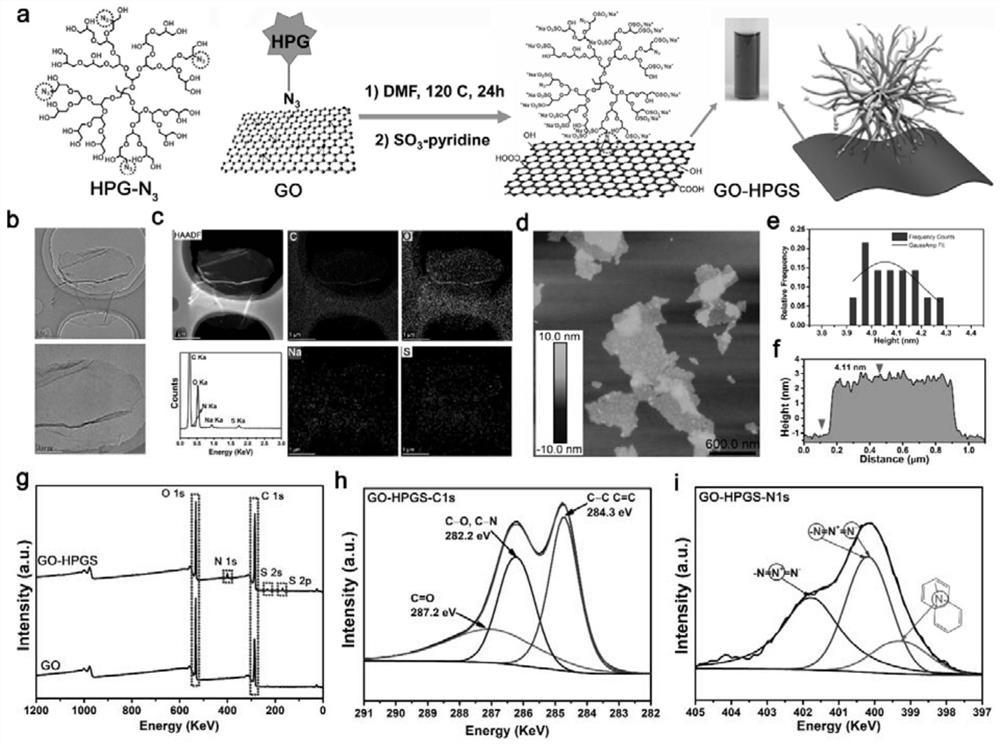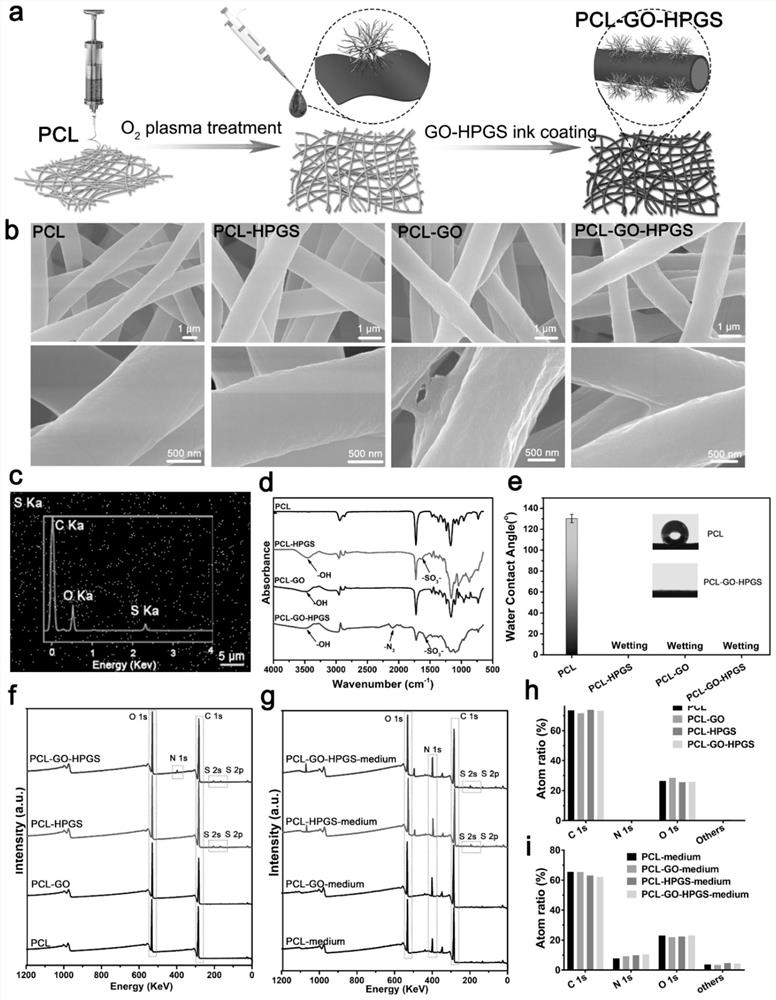Two-dimensional hyperbranched polyanion nanosheet modified nanofiber scaffold and preparation method and application thereof
A nanofiber, fiber technology, applied in the direction of fiber type, fiber treatment, pharmaceutical formulation, etc., to achieve broad application prospects, efficient dryness, and the effect of maintaining dryness
- Summary
- Abstract
- Description
- Claims
- Application Information
AI Technical Summary
Problems solved by technology
Method used
Image
Examples
Embodiment 1
[0054] Example 1: Preparation of polycaprolactone fibers (PCL-GO-HPGS) coated with GO-HPGS nanosheets
[0055] 1. Preparation and characterization of GO-HPGS 2D nanosheets (1.1) Azidated hyperbranched polyglycerol (HPG-N 3 )Synthesis
[0056] First, referring to the literature (Advanced Materials 2014, 26 (17), 2688-2693; Angewandte Chemie International Edition 2014, 53 (43), 11650-11655) to synthesize hyperbranched polyglycerol (HPG) by one-step ring-opening anionic polymerization (ROAP) ) crude product, then the crude HPG product was dissolved in methanol and dialyzed for 3 days for further purification. Centrifuge to remove insoluble precipitates, take the supernatant and concentrate, and dry at 60°C overnight under high vacuum to remove residual methanol to obtain hyperbranched polyglycerol (HPG), molecular weight = 7200g.mol -1 , PDI<1.2, branching degree 50%.
[0057] HPG (3.5 g) was dried overnight at 60° C. under high vacuum (HV). The dried HPG was then dissolved i...
Embodiment 2
[0073] Example 2: Preparation of polycaprolactone fibers (PCL-GO-HPGS / 2) coated with GO-HPGS nanosheets
[0074] Using the same method as in Example 1 to prepare PCL fibers and GO-HPGS nanosheets, and then use O 2 The PCL fibers obtained in the previous step were treated with plasma for 0.5 min to generate hydrophilic groups and convert the surface of the hydrophobic polymer to hydrophilic, which facilitated covalent bonding with GO-HPGS nanosheets. then O 2 After plasma treatment, the PCL fibers were soaked in the GO-HPGS nanosheet dispersion (the concentration was 0.5 mg / mL, the solvent was H 2 O), soaked for 0.5min, and then removed to obtain coated GO-HPGS nanosheets, dried under vacuum overnight to obtain GO-HPGS nanosheets coated PCL fiber, named PCL-GO-HPGS / 2.
Embodiment 3
[0075] Example 3: Preparation of polycaprolactone fibers (PCL-GO-HPGS / 3) coated with GO-HPGS nanosheets
[0076] Using the same method as in Example 1 to prepare PCL fibers and GO-HPGS nanosheets, and then use O 2 The PCL fibers obtained in the previous step were treated with plasma for 3 min to generate hydrophilic groups and convert the surface of the hydrophobic polymer to hydrophilic, which facilitated covalent bonding with GO-HPGS nanosheets. then O 2 After plasma treatment, the PCL fibers were soaked in the GO-HPGS nanosheet dispersion (the concentration was 3 mg / mL, the solvent was H 2 (0), soak for 5min, and then take it out to obtain the coated GO-HPGS nanosheets, and dry them overnight under vacuum to obtain PCL fibers coated with GO-HPGS nanosheets, named as PCL-GO-HPGS / 3.
PUM
| Property | Measurement | Unit |
|---|---|---|
| Concentration | aaaaa | aaaaa |
| Concentration | aaaaa | aaaaa |
| Thickness | aaaaa | aaaaa |
Abstract
Description
Claims
Application Information
 Login to View More
Login to View More - R&D Engineer
- R&D Manager
- IP Professional
- Industry Leading Data Capabilities
- Powerful AI technology
- Patent DNA Extraction
Browse by: Latest US Patents, China's latest patents, Technical Efficacy Thesaurus, Application Domain, Technology Topic, Popular Technical Reports.
© 2024 PatSnap. All rights reserved.Legal|Privacy policy|Modern Slavery Act Transparency Statement|Sitemap|About US| Contact US: help@patsnap.com










